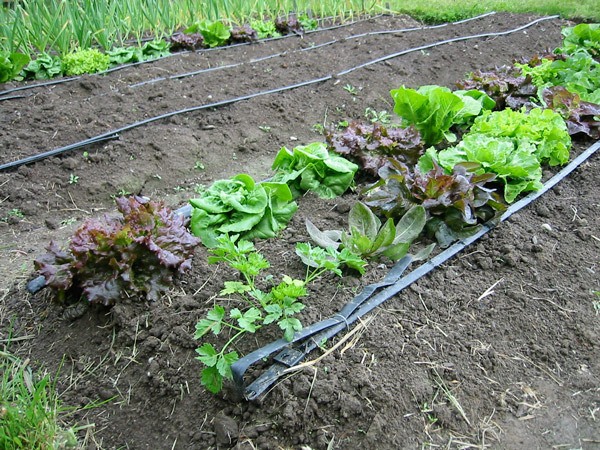Consistent and effective watering is key to a successful vegetable garden. Some may think that watering is the easiest task in the garden, but many gardeners make mistakes.
When to water
Water your plants when soil conditions indicate a need for water, not according to the calendar. Typically, when soil is dry 1-2 inches below the soil surface, it is time to water.
It is better to water deeply and less frequently allowing deeper penetration of the water into the soil. This encourages plants to grow deep roots, preparing them for periods of drought.
Most vegetable plants require about 1 inch of water per week, whether supplied by nature or the gardener. One inch of water applied to the soil will soak down to 6-8 inches below the surface where most plant roots are found.
Some vegetables, like lettuce and spinach, have shallow root systems which dry out quickly, so you may have to water them more frequently than other vegetables. Seedlings also need more frequent watering until they become established.
It is best to water your garden early in the morning. This limits water loss to evaporation, but also allows adequate time for foliage to dry, minimizing the risk for fungal problems. But if plants are wilted, water immediately.
Watering methods
There are a variety of methods that gardeners can use to water their vegetable gardens. The simplest approach is a watering container.
Although this method is time-consuming, it can be effective at directing the water to where it is needed by the plant: its roots. It also allows an individualized watering schedule for more sensitive plants.
The most common method for watering is by a hose. Sadly, it is probably the most ineffective technique since it usually waters a large area with a high velocity of water. This can lead to a lot of runoff from your garden beds since the soil can only absorb so much water in a small amount of time.
Also, it is difficult to target the water only at the roots; stems and leaves usually get wet, increasing chances for a variety of diseases in your garden.
Soaker hoses are a popular choice since they are easy to install and relatively inexpensive. This type of hose has tiny holes in it that trickle water along its length. Little water is lost since the soil is able to absorb the slow trickle. Plus, the water is targeted at the soil level. The small openings on soaker hoses can become clogged after a season’s use, so frequently check the hose for effectiveness.
One of the most efficient ways to water is drip irrigation. Unfortunately, this sort of system requires more know-how and can cost substantially more than other methods. Larger diameter plastic tubing is laid along garden beds; smaller tubes with water emitters are attached to these main lines, directing water to individual plants. Kits can be purchased which contain the basic components of a drip system which makes installation easier.
But gardeners still need to study their garden’s water needs and the ability of the system to deliver sufficient water.
Because the severe drought conditions of 2015 could happen again, gardeners should understand when and how to water their gardens and make the most efficient use of the water they have.
Pearl of Wisdom
Plants in need of water show characteristic signs such as wilting or drooping, marginal scorching of leaves, tip dieback and fruit drop. But beware, overwatering suffocates a plant’s roots and can show these same signs. Always check the soil to see how dry it is before watering.
For more
For more gardening information, attend a Saturday in the Garden presentation at the Master Gardener Demonstration Garden at 2711 Woodcock Road in Sequim. These free educational events are held at 10 a.m. on selected Saturdays. On June 18, veteran Master Gardener Ann Murakami will talk about lasagna gardening (also known as sheet composting).
Lorrie Hamilton is the Clallam County Master Gardener program coordinator.


